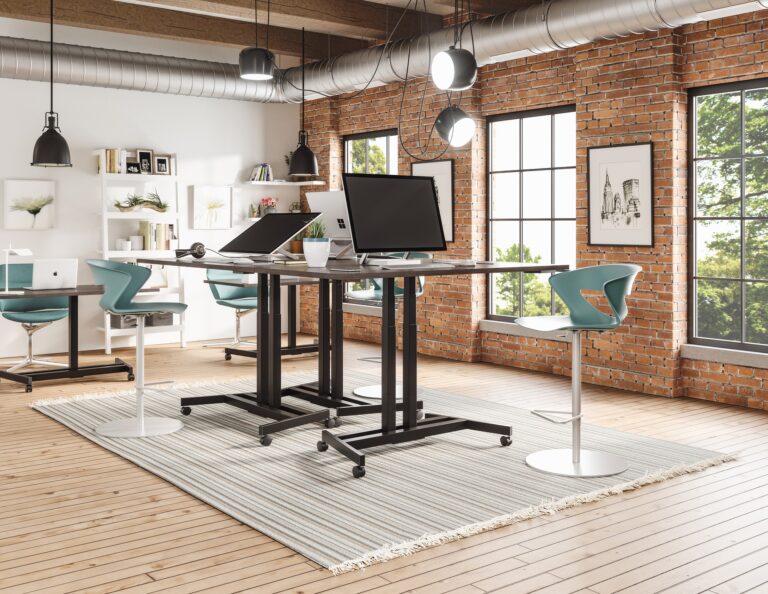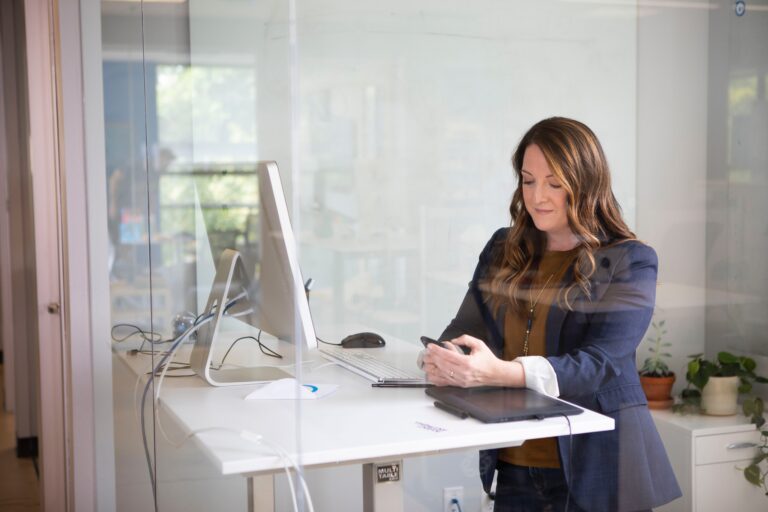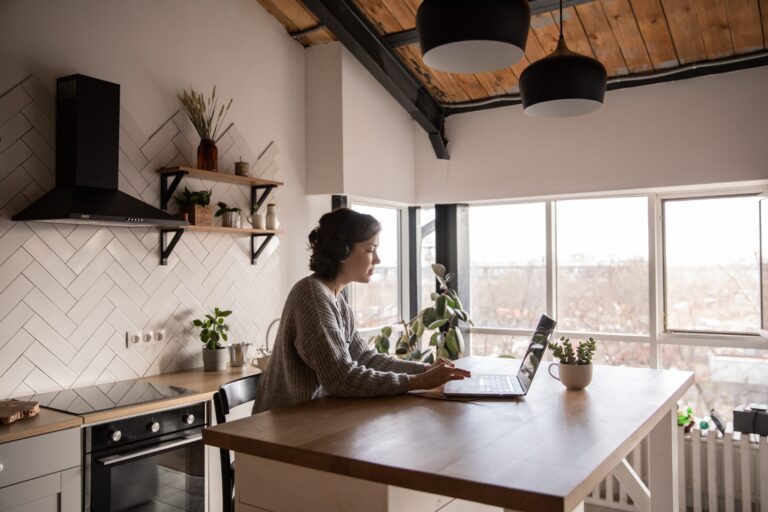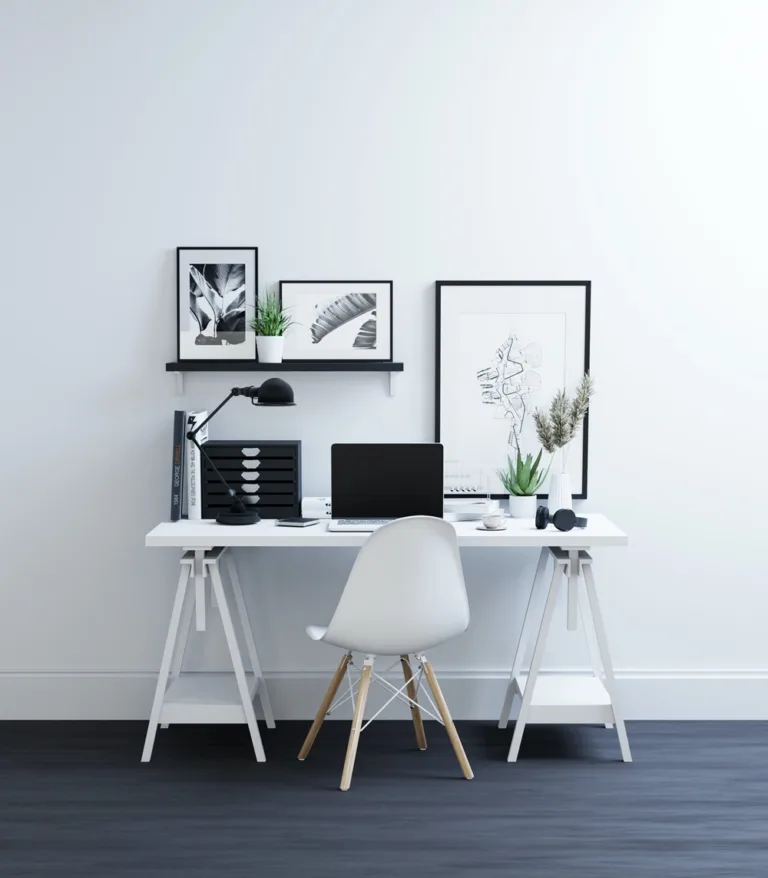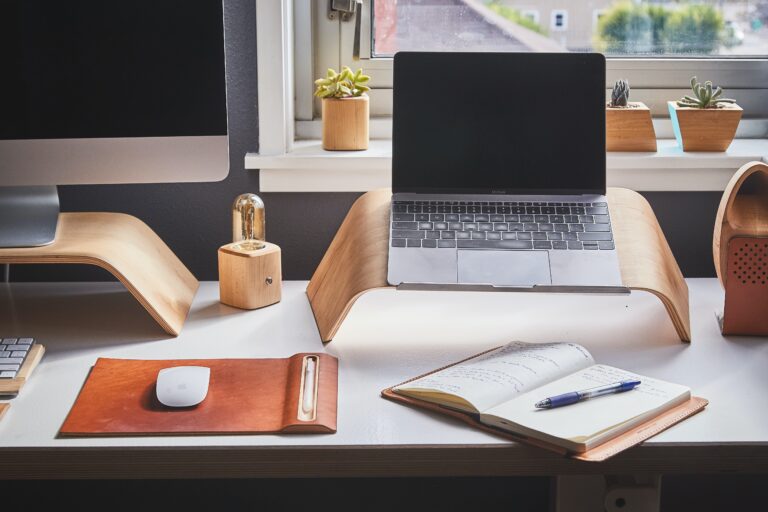The pros and cons of using standing desks vs sitting at work have come under greater scrutiny over the last few years, especially since the COVID-19 pandemic paved the way for remote-first ways of working.
For many workers across different sectors, the majority of time is spent hunched over screens for hours. Coupled with the more sedentary lifestyle that comes with remote working, having the right choice of desk setup can significantly affect our health, productivity and overall well-being.
Here, we explore the pros and cons of standing desks vs sitting, to help you make an informed decision about which desk type best suits your lifestyle and needs.
Standing desks
Standing desks, also referred to as height-adjustable desks, are workstations designed to accommodate working while standing upright rather than sitting. Standing desks are usually smaller than other sitting desk styles, because they can be elevated to a height that allows the user to stand comfortably. Standing desks come in various configurations, including fixed-height and adjustable-height desks.
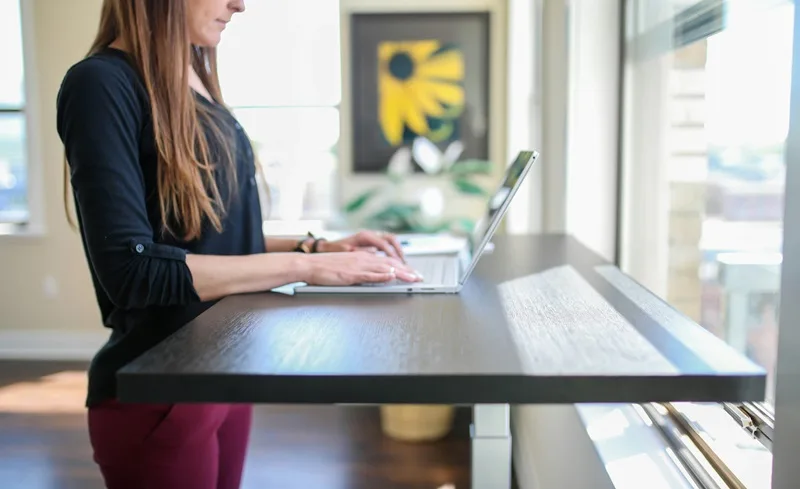
A standing desk can promote better posture and reduce sedentary behaviour associated with long periods of sitting. Advocates of standing desks claim they have many health benefits, including improved circulation, increased energy levels, and a reduced risk of certain health conditions such as obesity and cardiovascular disease. Standing desks also offer flexibility as the work day progresses, allowing users to alternate between sitting and standing throughout the day depending on how they’re feeling.
The benefits of standing
Here are some of the main advantages linked to standing desks:
Improved posture
Because you’re encouraged to stand upright and straight when using a standing desk, this can help to align the spine more naturally (compared to sitting in a more hunched position at a desk). Better posture can alleviate strain on the neck, shoulders and back, reducing the risk of musculoskeletal issues such as back pain, neck pain and headaches.
Better circulation
Sitting for long periods can lead to poorer blood flow as it becomes more restricted to the legs and feet. Standing desks encourage you to move and shift your weight around during the day, which helps to reduce the risk of varicose veins and deep vein thrombosis, which in turn can aid cardiovascular health.
Increased energy and alertness
Some users of standing desks claim they make them feel more awake and alert as the working day continues into later hours, when productivity may slump. Standing promotes better blood flow to the brain, which can enhance cognitive function and concentration. Improved mental focus can lead to improved productivity.
Lower risk of chronic diseases
Sitting down for long periods can lead to an increased risk of developing type 2 diabetes, cardiovascular disease, and certain types of cancer. Standing desks could help to reduce the risk of developing these conditions, and could aid the metabolism, which helps to control blood sugar and cholesterol levels. [1]
Improved well-being
Standing desks could have psychological benefits. Some users report feeling happier and more satisfied at work when using a standing desk, possibly due to the increased sense of autonomy and control over their workspace. As standing encourages more movement, this can help to release endorphins, which can boost your mood.
Check out our article and discover more benefits of a standing desk.
Drawbacks of standing
That said, standing desks do have their limitations. Here are a few:
Muscle fatigue
Standing for long periods of time can lead to muscular discomfort and aches. It can particularly make your legs, feet, and lower back sore and stiff. Standing places increased strain on your lower body, and if you’re not used to standing up often, it may be difficult to adjust to, which could hinder productivity.
Risk of varicose veins
Frequent and long periods of standing can also contribute to the development of varicose veins, because standing puts extra pressure on the veins in the legs. Standing desks may exacerbate this risk, especially if you don’t shift your weight frequently. Varicose veins can be very uncomfortable to deal with, causing swelling and pain in the legs and feet.
Foot-related health problems
Standing desks can lead to foot problems, including inflammation in the Achilles tendon. Standing in inappropriate footwear that isn’t supportive can also strain the ligaments and tendons in the feet. People with pre-existing foot conditions may find that using a standing desk exacerbates their symptoms. [2]
Fatigue
Standing desks can give you an energy boost initially, but over time it’s common to feel fatigue and a lack of focus. Standing for prolonged periods can be physically demanding, leading to decreased stamina and concentration. This can make it more challenging to stand for a long time without feeling exhausted.
Workspace ergonomics
Not all standing desks are built to support posture and comfort. Some models may lack adjustment or the ability for configuration, leading to awkward positioning and excess strain on the body. Standing desks are also quite small when compared to some sitting desks (like larger corner-style units), which limits their practicality for certain individuals or professions.
Sitting desks
Sitting desks still remain the most popular choice in many working environments, especially as many have an ergonomic design or the space needed for a lot of equipment.
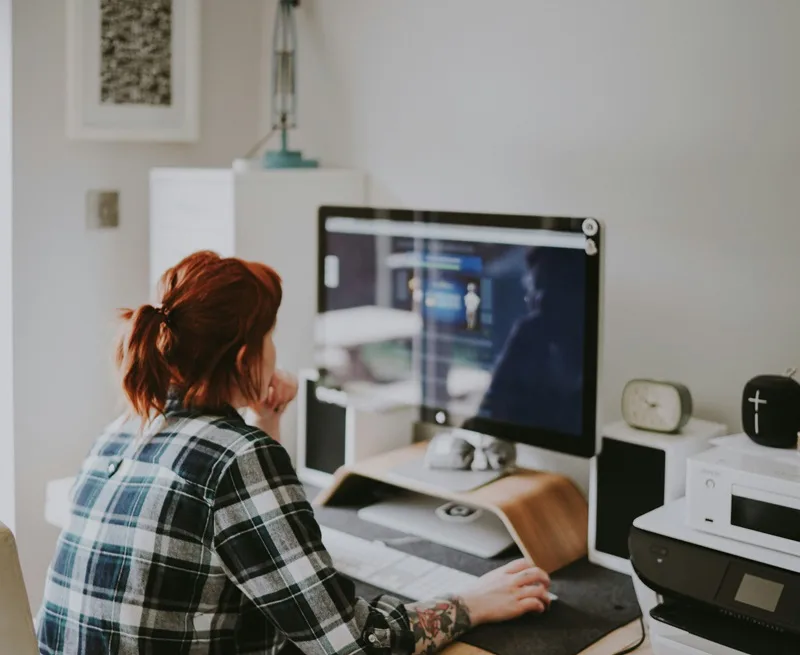
Benefits of sitting desks
While standing desks have gained popularity in recent years, sitting desks still remain a staple in an office environment. Here are some reasons why:
Comfort
Sitting desks typically have an ergonomic design and features, allowing you to adjust the height, position and angle of your workspace to suit your preferences, which can help if you’re going to spend a long amount of time there.
Sitting desks can be paired with ergonomic accessories such as adjustable chairs, footrests, and lumbar supports. These accessories help promote proper posture and reduce the risk of musculoskeletal discomfort and injuries.
Stability and support
Standing desks that are adjustable can be unstable, especially if a lot of equipment is placed upon them. Sitting desks are much more secure for equipment such as computers and laptops, without worrying about balance or stability issues.
Aesthetics
Sitting desks are widely available in a wide range of colours, finishes and styles, and can be easily integrated into various office environments. They can be combined to suit different office layouts and user preferences. Unlike standing desks, sitting desks can also be customised with accessories such as monitor stands, keyboard trays and cable management systems to make them more organised.
Drawbacks of sitting desks
Here are some of the most common limitations of sitting desks.
Health risks with prolonged sitting
Extended periods of sitting have been linked to various health risks, including obesity, cardiovascular disease, diabetes and musculoskeletal problems. Sitting for long hours without frequent breaks can lead to muscle soreness and stiffness, increased pressure on the spine, and problems with blood circulation.
Tight muscles and stiff joints can also increase the risk of injury during physical activity, and may contribute to chronic pain and mobility limitations over time.

Musculoskeletal issues
Sitting desks can contribute to musculoskeletal discomfort and pain, particularly in the back, neck, shoulders and wrists – especially when sitting for long periods. Sitting desks can also contribute to repetitive stress injuries such as carpal tunnel syndrome and lower back pain.
Reduced physical activity and well-being
Sitting desks promote a sedentary lifestyle, and a lack of movement means burning fewer calories and a higher risk of developing chronic health conditions such as diabetes and heart disease, not to mention a reduction in physical fitness.
Prolonged sitting can lead to feelings of lethargy, decreased motivation and reduced brain function, ultimately affecting mood and overall well-being, which can lead to a higher risk of stress, depression, and anxiety.
Is standing better than sitting during work?
Using standing desks and sitting desks both have their own advantages and disadvantages, so it’s important to consider the following when working out what is best for you.
Health considerations
Standing desks have many health benefits, including improved posture, burning more energy, and a reduced risk of certain health conditions such as obesity and cardiovascular disease.
It’s important though that you don’t stand for too long, as prolonged periods of standing can be just as troublesome, leading to fatigue, muscular issues and increased risk of varicose veins and foot problems. Instead, create a balance of both sitting and standing to get the benefits of both.
Job requirements
The nature of your job could be a factor in deciding whether standing or sitting is better for you. Jobs that require long periods of focus, such as computer work, or some kind of crafting work that requires precision, could be better suited to sitting desks, as they provide stability and support for precise movements. Jobs involving regular movement or customer interaction could be better for standing desks, as they’re more flexible.
Ergonomics
Whether you’re sitting or using a standing desk, your working environment should be ergonomic and adjustable to promote optimal posture, including the height of your desk, chair, monitor and keyboard to reduce strain on your muscles and joints.
Well-being
Regardless of whether you’re sitting or standing, your workday should have plenty of variation. This includes alternating between the two, and taking regular breaks to move your body. By being aware of when your body feels tired, achy or stiff, you can be more productive while supporting your well-being.
Adjustable sit-stand desks
Adjustable sit-stand desks offer the flexibility to switch between sitting and standing positions throughout the workday. The desks feature a mechanism that easily adjusts the height of the desk surface, enabling them to alternate between sitting and standing positions as needed. This promotes movement, reducing the negative effects of sitting down for long periods.
Research suggests that alternating between sitting and standing throughout the day can help improve circulation, reduce muscle fatigue, and relieve musculoskeletal discomfort. By finding a balance between sitting and standing, these desks can support productivity in the workplace.
How to stay active during the workday
Here are some top tips to help you stay active while at work. You can find more advice in our guide to staying active when working from home.
1. Take regular breaks
Set reminders to take short breaks every hour to stretch your muscles, stand up, or walk around.
2. Move during meetings
Instead of sitting for a long meeting, encourage shorter standing discussions. This not only adds physical activity but also boosts engagement.
3. Use a standing desk
As we’ve discussed, standing desks help you alternate between sitting and standing, promoting better posture and encouraging movement.
4. Do some desk exercises
Why not try some chair squats, ankle circles, arm stretches, calf raises or desk push-ups? These exercises can be done discreetly and help prevent muscle stiffness. Focus on areas prone to stiffness, such as the neck, shoulders, back and hips.
5. Active commuting
If you are working in-person rather than at home, ride a bike, take public transport and walk to work, or park further away from your office to add extra steps to your daily commute. You can also take the stairs to your desk rather than the lift.
6. Sit using an exercise ball
Temporarily replace your desk chair with a stability ball to engage your core muscles while sitting. This can help improve balance and posture throughout the day.
7. Stand while taking calls
Instead of sitting at your desk, pace around while taking phone calls to get some extra steps in during the day.
8. Check your desk ergonomics
Ensure your workstation is set up ergonomically. Adjust your chair height and monitor position to support good posture.
9. Take walks at lunchtime
Use your lunch break as an opportunity to go for a walk outdoors. This is great for releasing any muscle tension and reducing stress levels.
Sources
[1] NHS – Why Sitting Too Much is Bad For Us – https://www.nhs.uk/live-well/exercise/why-sitting-too-much-is-bad-for-us/
[2] National Library of Medicine – Evidence of Health Risks Associated with Prolonged Standing at Work – https://www.ncbi.nlm.nih.gov/pmc/articles/PMC4591921

